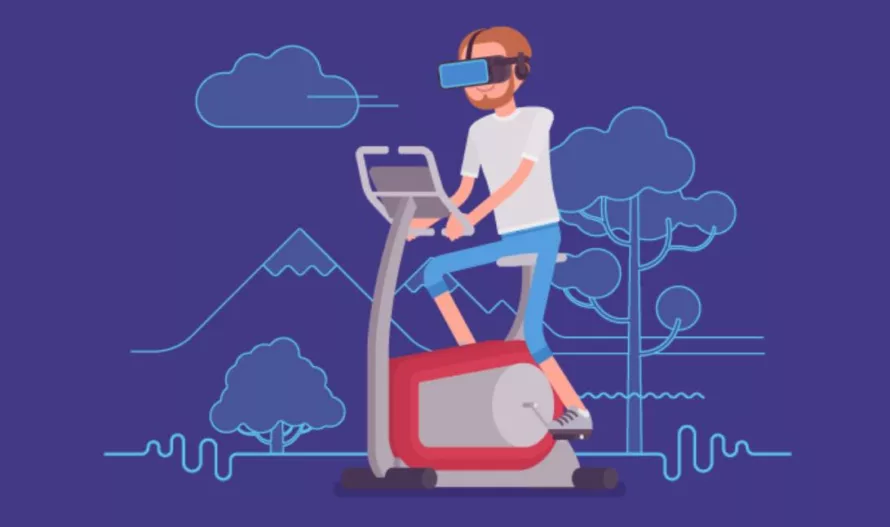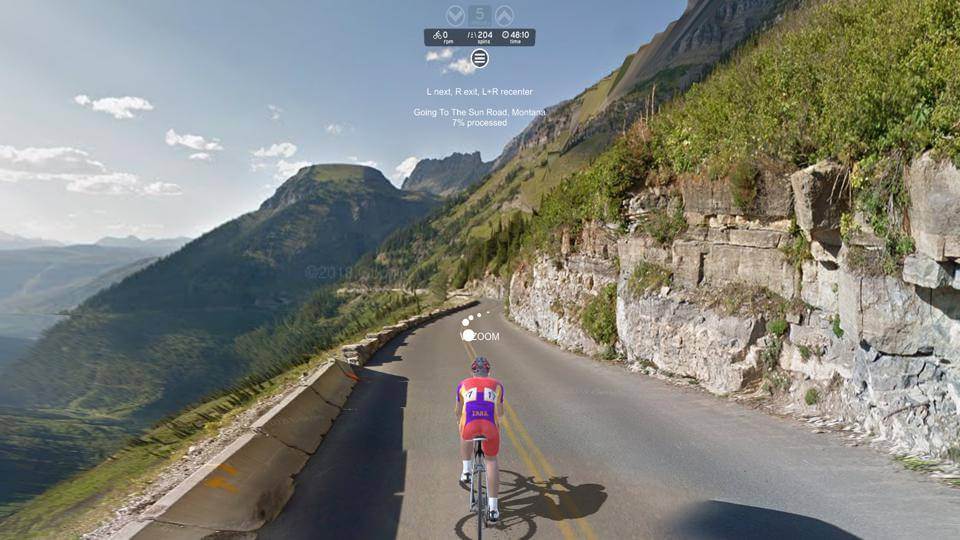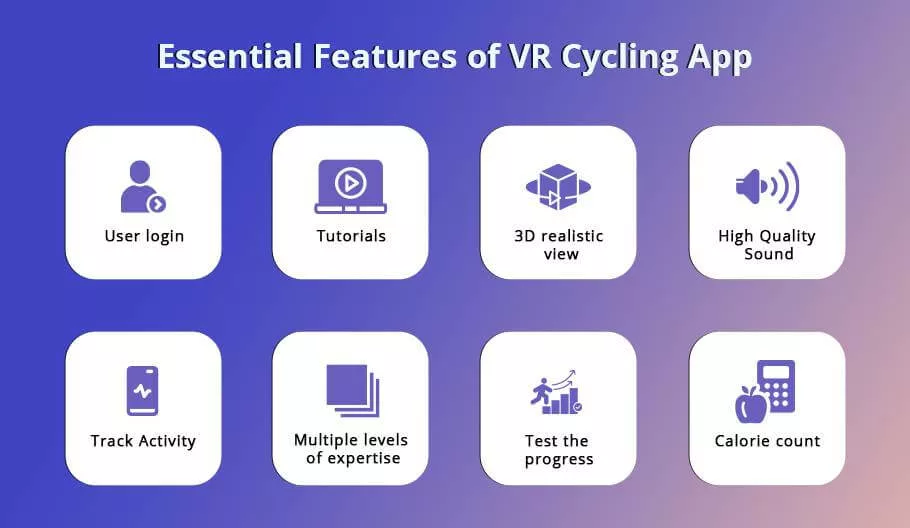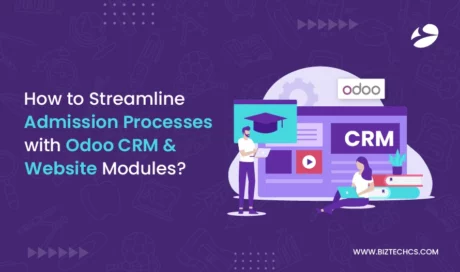3921
Cycling the World in Virtual Reality: A Handy Guide for Your VR App
22 Oct, 2020
13 min read
3921
22 Oct, 2020
13 min read

If you are reading this, we suppose you are into the fitness industry. Let’s be a little honest here. The industry is crumbling. Many gyms and other fitness institutes have shut down permanently as owners face financial challenges.
However, fitness brands and studios are leveraging digital opportunities to keep the ball rolling. Even you might have started online training sessions on Zoom or Skype.
That’s a great start. But have you thought of ways to boost client engagement and attract new members?
You need to be creative. And there’s nothing better than letting the customers burn calories while they travel the world in virtual reality.
That’s what we are going to talk about today. Virtual cycling – a fun and engaging workout.
In this article, we will explore how VR can benefit both you and your customer. We will also talk about how you can provide a virtual experience by creating your own app.
Let’s begin!
A quick index of the blog post
Before we get into the nitty-gritty of virtual reality and fitness, you need to understand the difference between AR and VR. These terms appear everywhere on the internet and non-technical users tend to get confused.
Virtual reality is a computer-generated simulation of an alternate world or reality. While Augmented reality adds digital elements to a live view by using the camera on a smartphone or tablet.
For now, this is what you need to keep in mind: VR in fitness is all about offering an immersive environment with physical activities. And this technology is shaping the fitness world for good.
Well, studies are in favor of it. San Francisco State’s Department of Kinesiology conducted a study that put 41 men and women between the ages of 18 and 39 through three games and measured their heart rates and oxygen consumption. The study found that 30% of general virtual reality games give you a pretty good workout. This CNN article has documented all you need to know.
Black Box VR is the world’s first virtual reality gym experience. Here, you enter the Black Box room with your fitness headset and immerse yourself in a whole new world created around you. You get a full body workout that is so immersive that you forget you are working out at all.
Black Box VR is just one of many companies experimenting with VR. Icaros have created a VR experience that makes them the main character in a video game, all the while working out key muscles throughout the body.
There’s a lot that goes behind into building a VR app for cycling. We can help you assess interactive VR solutions that will keep your clients motivated.
Cycling on a stationary bike is one of the best forms of exercise. However, it can get boring. So, companies are using virtual reality technology to give users a realistic experience via immersive environments. VR cycling is not a new concept but in the last few years, it has started receiving more attention. It has become a leading fitness solution for gym goers and indoor cyclists.
VR cycling applications require three key hardware items: a stationary bike, sensor kit, and a headset. The user first puts the VR headset on, chooses the environment they would like to use and then just peddles away! The user can even set training elements like time, distance, or compete in by activating the competition mode.
Let’s look at some unique and innovative virtual reality solutions that fitness companies are offering.
VirZOOM’s VZfit allows you to connect a stationary bike to an Oculus Quest or Oculus Go headset. The kit includes a Bluetooth pedal mounted sensor and a simple Bluetooth controller. By transforming every ride into an adventure, this VR solution has witnessed a 45% increase in usage since 1st March 2020.

BigRing virtual cycling brings VR cycling experiences to your home with over 350 different rides from 11 countries. It comes with built-in workouts and a coach functionality to help you with the pacing of your ride.
Customer Engagement – as a business owner you know how difficult it is to keep your client engaged, especially when you deal with fitness training and workout which could be mundane for some. When you put efforts to design a virtual reality app, you provide unique and interactive experiences to your clients. This life-like experience is the key to keep them engaged and retain their loyalty.
Some Fame Your Way – These apps make it possible for people to share their experiences on social networks. This will create a buzz about your brand online and you will see new clients approaching you.
VR became mainstream in 2012 after the launch of Oculus Rift. In 2014, Facebook bought the company for 2 million dollars, after VR gained momentum. Virtual training is the present trend and you must grab the opportunity by developing an app which has the potential to take your fitness brands to the next level.
Looking for VR solutions for your business? Let’s help you in creating a life-like VRcycling experience.
The journey of incorporating VR begins by creating VR content. Let’s discuss what the process looks like.
There are two ways of creating content for a virtual reality app
1. 360-degree Immersive Video
One way to create VR content is making a 360-degree video. To begin with this, you need a spherical camera with a 360-degree lens. When choosing a camera make sure that you can capture the highest possible quality video. You can film the video using a tripod, drone, or other viable options. After you create a video, the next step is to edit and bring all the footage in one piece. For this, you can use editing software like Videostitch.
Pro-tip- to get the best results; experiment with editing, use bold angles, and make it as engaging and entertaining as possible.
A good virtual reality video includes these elements:
Thus, 360-degree videos are a fantastic way to keep your audience engaged and motivated.
2. 3D Animation
3D animation is the process of generating three-dimensional moving images in a digital environment. By using 3D software, you manipulate 3D models or objects to give them the illusion of animation or movement.
There are several tools and platforms available in the market to create simple virtual 3D environments. The Structure Sensor camera works as a 3D scanner which will enable you to capture objects in the real world, and instantly create 3D models of them. You can even make use of game engines like Unity or Unreal.
If you think this is time-consuming, you can always take the help of experts who will create the video content for you.
A good 3D graphic must include these aspects:
Now that you have the content for your virtual reality app, let’s find out what goes into the development process.
This section includes all the information you need to know about app development tools and frameworks.
VR app development begins by choosing a software development kit (SDK). A Software Development Kit is a set of tools allowing you to create your application. It includes a range of things such as documentation, code samples, guidelines, etc. required to develop an app. An SDK is necessary to create the standard features and components of the application easily and quickly. We have selected some SDKs popular for creating a VR app– OpenVR SDK, Oculus SDK, Google VR SDK, PSVR dev kit.
Here’s what you need to consider before choosing a development kit:
A game engine provides you with the framework to build an app. The primary use of a game engine was for game development but developers use it for 3D construction as well. So, with its help you can efficiently create and edit 3D characters and fully immersive 3D experiences. Unity, Unreal Engine, GameMaker, are the best engines for VR development. Most of these engines are free, and you can easily integrate them with platform-specific SDKs.
These engines work as a base for providing effective real-time visualization. And isn’t virtual reality all about that? 3D animated graphics, algorithms related to sound, artificial intelligence- the game engine manages everything.
Sometimes, the process of development becomes complex. That’s when a framework comes into the picture. It eases the process of development by providing a proper structure.
Example – WebVR framework and library: it is a small piece of JavaScript that runs in the browser on the web and provides an API for use in virtual reality (VR) applications. WebGL: allows your application to present graphics on the browser.
We can help you build a VR cycling app from scratch. Get in touch with us!
Before you think about designing the app, you must have first-hand experience of what a VR app feels like. We suggest that you download a couple of apps and explore everything – the design, and the user experience. Then think about what kind of experience you wish to give your users. Start with creating user personas, conceptual flow, and wireframes, and therefore a blueprint of the mobile app.
Make sure that your VR app has an intuitive user interface. An intuitive interface is one that works the way the user expects it to. Your design should be such that the user doesn’t have to think about what next to do. If you are not able to guide the user through whatever they want to achieve, there are high chances you might lose that user.
Your VR app needs hardware to run. There are some common VR hardware types:
Prototyping is a must to make your app successful. The aim of a prototype is to communicate the product’s design and navigation flow. This helps to maximize the efficiency of application development. By giving an idea of the product’s look and feel beforehand, it lets you make changes before it’s too late. You need to consider prototyping VR experience for testing purposes. You can test a 360-degree view, get an idea of scale and depth, know the viewing position of the viewer and other such attributes. Google Blocks, Cinema 4D, Photoshop, Sketch, Framer, and A-Frame are some prototyping tools available.
Deciding features depends upon your budget and other requirements. However, here’s a list of features that your app can’t do without.

To create an app, you need a team. If you do not want to take the pain of finding a new team then it is a good idea to hire a development company. Most companies have a team of designers, developers, quality assurance engineers, and product managers. Their expertise and experience will help you get expected results in a short time.
Want to have a chat about how to get in the virtual world?
All product and company names are trademarks™, registered® or copyright© trademarks of their respective holders. Use of them does not imply any affiliation with or endorsement by them.
Odoo
99
By Devik Gondaliya
02 Jul, 2025

Odoo
414
By Devik Gondaliya
25 Jun, 2025

Odoo
1035
By Devik Gondaliya
12 Jun, 2025